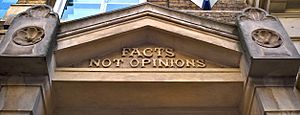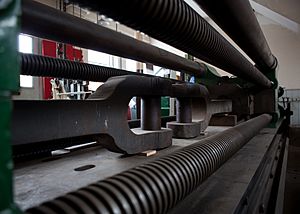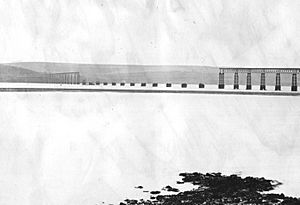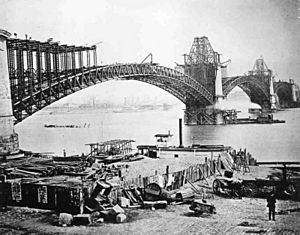Kirkaldy Testing Museum facts for kids
 |
|
| Lua error in Module:Location_map at line 420: attempt to index field 'wikibase' (a nil value). | |
| Established | 1983 |
|---|---|
| Location | Southwark London, SE1 United Kingdom |
| Public transit access | |
The Kirkaldy Testing Museum is a super cool place in Southwark, south London, England. It's inside the old workshop of a brilliant inventor named David Kirkaldy. The museum is home to his giant testing machine, which is truly amazing, along with many other smaller machines. You can visit the museum on the first Sunday of every month to see these incredible inventions in action!
The building itself is very old and important. It became a special "listed building" in 1971, which means it's protected because of its history. In 2014, it was given an even higher protection level, called Grade II*.
Contents
Who Was David Kirkaldy?
David Kirkaldy was born in Scotland in 1820. He went to Edinburgh University and later worked at a big shipbuilding company. There, he became the main designer and calculator. In 1861, he decided to leave and spend the next two and a half years studying how materials were tested. He then designed his very own testing machine! Before him, people like William Fairbairn had already started measuring how strong materials were and how they behaved under stress.
Kirkaldy paid for his machine to be built by a company in Leeds. He watched over its creation very closely. After 15 months, he was a bit annoyed that it was taking so long, so he had the unfinished machine brought to Southwark in September 1865.
The Giant Testing Machine
Kirkaldy's testing machine is huge! It's about 14.5 meters (47 feet 7 inches) long and weighs around 116 tons. Imagine a machine as long as a bus and as heavy as many elephants! It works by pulling things apart horizontally using a powerful water-powered system.
Here's how it works:
- Water is pumped into a special cylinder, which creates a lot of pressure.
- This pressure pulls on the material being tested.
- A clever weighing system, with levers and a sliding weight, measures how much force is being used.
- As the pressure increases, the operator moves the sliding weight along a scale.
- When the material breaks, the number on the scale tells you exactly how much force it took to break it.
The machine can measure forces up to an incredible 1,000,000 pounds (about 450 tons)! That's like testing if a material can hold the weight of 10 large trucks! Today, when the museum shows how it works for visitors, they use a smaller force, usually not more than 20 tons.
Kirkaldy also figured out ways to look at tiny parts of metals using special microscopes. This helped him understand why some materials were stronger than others.
Famous Tests and Discoveries
The Kirkaldy works tested parts for many important structures and even helped figure out why some things failed.
- Bridges: They tested parts for the Eads Bridge in the USA (finished in 1874) and the Hammersmith Bridge in London (1887).
- Buildings: They tested materials for the old Wembley Stadium (built in 1923) and the Skylon tower for the Festival of Britain in 1951.
- Accident Investigations: The museum also helped investigate big accidents, like the Tay Bridge Disaster in 1879 and a plane crash involving a De Havilland Comet in 1954.
The Tay Bridge Disaster
In 1880, Kirkaldy played a very important role in finding out why the first Tay railway bridge collapsed. This terrible accident happened on December 28, 1879. Kirkaldy tested many pieces from the bridge. He found that the cast iron parts, which were supposed to be very strong, broke easily. These parts were meant to hold 60 tons of force, but they broke at only about 20 tons! This was a major reason why the bridge fell down.
Kirkaldy's tests showed that some of the cast iron parts had hidden flaws, like air bubbles inside them, which made them much weaker. The strong wrought iron beams of the bridge, however, survived the collapse much better. Some of these beams were even reused in local houses and later moved to the Royal Museum of Scotland in Edinburgh for display.
The Kirkaldy Testing Works Building
David Kirkaldy first used his machine in a different building. But his business grew, so in 1874, he moved to a bigger, specially built place at 99 Southwark Street. This is where the museum is today!
The new building was designed by an architect named Thomas Roger Smith. It looks like an old Italian building. It has four floors and is made of brown and yellow bricks. In the middle of the building, you can still see a sign that says "Kircaldy's Testing and Experimenting Works." Above the door, there's a motto: "Facts not Opinions." This means Kirkaldy believed in proving things with tests, not just guessing!
The heavy testing machine was placed on the ground floor, supported by strong brick pillars in the basement. The testing room still looks much like it did back then, with its original shelves and wooden walls. In the basement, there's another machine, called a Denison machine, which Kirkaldy bought in 1906 to test big marine chains.
After David Kirkaldy passed away in 1897, his son and then his grandson continued to run the testing business. The business eventually closed in 1974. The upper floors of the building became offices, but the basement and ground floors were reopened as the museum in 1984.
Today, the museum is run by volunteers. It's a fantastic place to learn about engineering and the history of testing materials. They even have a "Material Difference" learning program to help students learn about science, technology, engineering, and math (STEM).




